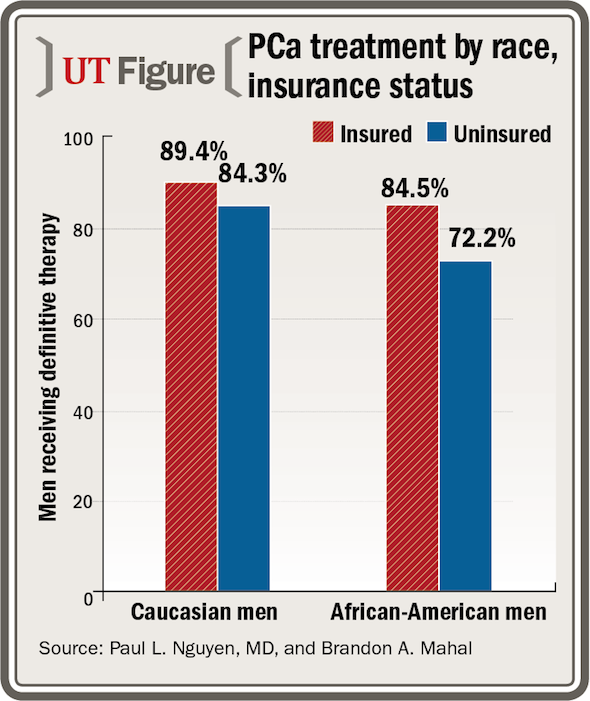Article
Data suggest racial disparity in high-risk PCa treatment
Results of a study analyzing data from the Surveillance, Epidemiology, and End Results program add to evidence of race-related disparity in receipt of treatment for prostate cancer, but show that having health insurance reduces the difference in care.
Boston-Results of a study analyzing data from the Surveillance, Epidemiology, and End Results (SEER) program add to evidence of race-related disparity in receipt of treatment for prostate cancer, but show that having health insurance reduces the difference in care.
Related - USPSTF PSA grade has ‘minimal’ impact on screening
Senior author Paul L. Nguyen, MD, told Urology Times, “Our findings suggest that expanding insurance coverage under the Affordable Care Act (ACA) may help reduce racial disparities in treatment patterns for high-risk prostate cancer, likely by increasing access to care.
“This would be particularly beneficial for African-American men with high-risk prostate cancer who are the most likely to face a poor prognosis, and most likely to be undertreated,” added Dr. Nguyen, associate professor of radiation oncology at Harvard Medical School, Boston.
The study, which was presented at the American Society of Clinical Oncology annual meeting in Chicago and published online ahead of print in the Journal of Geriatric Oncology (May 23, 2014), included data from 64,277 men diagnosed with localized high-risk prostate cancer between 2007 and 2010. High-risk disease was defined as PSA >20.0 ng/mL, Gleason score ≥8, or clinical stage ≥T3a. Insurance status was dichotomized as uninsured or insured, regardless of insurance type.
Multivariable logistic regression analysis adjusting for a variety of sociodemographic features and known prostate cancer prognostic factors identified both race and insurance status as being significantly associated with receipt of definitive treatment (p<.001 for both). African-American men were 40% less likely than Caucasian men to receive definitive treatment, while men with insurance were 1.8-fold more likely to receive definitive treatment than their uninsured counterparts.
Next: Insurance reduces disparity by 40%

More on Prostate Cancer
Medicare to cover one PCa test, PPO covers another
ADT overuse remains a problem among some urologists
Approval of enzalutamide pre-chemo a ‘game changer’
Insurance reduces disparity by 40%
Further analysis identified a statistical interaction between insurance status and race with respect to receipt of definitive treatment, such that having insurance reduced the racial disparity by about 40%. While African-American men were 62% less likely to receive definitive therapy than Caucasian men in the uninsured cohort, among men with insurance coverage, African-American men were only 38% less likely than Caucasian men to receive definitive therapy.
Lead author Brandon A. Mahal, a Harvard Medical School student, noted that additional analyses comparing men who were uninsured to those having either private insurance or Medicaid coverage found that Medicaid coverage also significantly reduced the racial disparity in receipt of treatment.
“This is an important finding because Medicaid is also being expanded under ACA,” he said.
Mahal explained that the years 2007 to 2010 were analyzed because 2007 is the first year in which SEER began publishing information on insurance status and 2010 was the most recent year for which data were available.
“Future studies will be needed to assess the true impact of the ACA on racial disparity in treatment for prostate cancer. However, the first post-ACA information will not become available for analysis for another 4 to 5 years,” Mahal said.
Discussing the limitations of the study, Mahal noted that the biggest issue is the lack of data on comorbidity in the SEER database.
“Without that information, we cannot rule out that some of the racial disparity found in our study might be due to different comorbidity rates within the different racial groups. However, in a sensitivity analysis, we used the rate of dying from causes other than prostate cancer as a means to evaluate how sick the patients were, and we found the same racial disparity in treatment receipt when we limited the analysis to patients having at least 3 years of follow-up after prostate cancer diagnosis,” he told Urology Times.UT
Subscribe to Urology Times to get monthly news from the leading news source for urologists.
Newsletter
Stay current with the latest urology news and practice-changing insights — sign up now for the essential updates every urologist needs.













